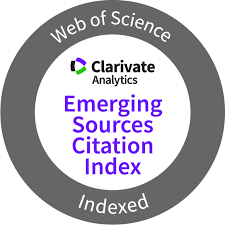Submissions
Submission Preparation Checklist
As part of the submission process, authors are required to check off their submission's compliance with all of the following items, and submissions may be returned to authors that do not adhere to these guidelines.- The text follows the style standards and bibliographic requirements described in Author Guidelines
Articles
The articles submitted must be unpublished and can be of the following types: scientific and technological research articles, reflection articles and literature review articles.
Authors must send 2 files:
The first file will have the authors' data including:
- Full name.
- Unique ORCID researcher identifier.
- Position and academic institution to which they belong.
- E-mail address.
- Percentage of the author's contribution to the research.
- State the availability or non-availability of data.
- One author must be chosen for correspondence.
The second file will contain the text of the article without the names of the authors in order to maintain anonymity.
The text should include:
1) Title of the paper in English, Spanish and Portuguese.
2) All articles must contain an abstract in Spanish, English and Portuguese of between 100-200 words, summarising the most important elements dealt with in the article. It should allow the reader to know the objective of the article.
3) Then, the articles should include between 3-5 keywords also in the languages: Spanish, English and Portuguese.
4) The structure of the articles must include at least an introduction and conclusions.
5) The sections and subtitles will be in Arabic numeral as follows: 1. Introduction, 1.1. Subtitle; 1.1.1. Second level subtitle and so on
6) Although there is no express limitation on the length of the article, it is recommended that it does not exceed 5000 words (10 pages, Times New Roman, Source 10, Single Line spacing).
7) The initials in the text must be accompanied, on the first occasion they are cited, with their full meaning. Example: The first time that self-compacting concrete (HAC) is cited, the acronym to be used in the rest of the article must be included in curved brackets
8) Remember that the photos that are necessary to include in the article will be printed in black and white. You are inserted in the body of the article.
9) The figures must be numbered in Roman numeration (I, II, III, IV, ...) and the title must go to the bottom of the figure beginning with Figure ...
10) The tables must also be inserted in the body of the article, numbered in Roman numeration (I, II, III, IV, ...) and the title must go to the bottom of the table starting with Table ...
11) Full bibliographic references should only be included at the end of the article and only those that are cited in the text.
12) The style for bibliographic references will be for all "Numbered" articles following the IEEE citation model. This means that in the text, a number (in straight parentheses) appears for each cited bibliographic reference. The list of references must appear at the end of the article in order of appearance (that is, respecting the numbers previously placed).
13) Bibliographic references of books cited in the article must present the following structure: Author, Title (in italics). City: Editorial, Year. For example:
[Citation number] J. M. Gere y S. P. Timoshenko, Mecánica de materiales. México: International Thomson editores, 1997.
14) The bibliographical references of journals cited in the article must present the following structure: Author, “Title,” (in quotes) Title of the Magazine (in italics), vol., No., Pp. - ?, Abbreviated month. Year. For example:
[Citation number] G. Alcuri, “Los elastómeros en la construcción: aplicaciones y valorización medioambiental,” Memoria Investigaciones en Ingeniería, no. 16, pp. 1-19. 2018.
Privacy Statement
The names and email addresses entered in this journal will be used exclusively for the purposes set forth therein and will not be provided to third parties or for use for other purposes.

















